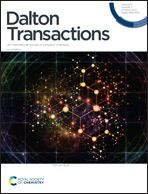A visible-light and temperature responsive host–guest system: the photoisomerization and inclusion complex formation of a ruthenium complex with cyclodextrins†
Abstract
In the present study, we investigated the visible-light- and thermal-stimuli-responsive properties of a host–guest system based on proximal- and distal-[Ru(C10tpy)(C10pyqu)OH2]2+ complexes (proximal and distal-1; C10tpy = 4′-decyloxy-2,2′:6′,2′′-terpyridine and C10pyqu = 2-[2′-(6′-decyloxy)-pyridyl]quinoline). The analogs of such ruthenium aqua complexes are well-known as metallodrugs and catalysts. The proximal isomer has a dicationic ruthenium center and hydrophobic alkyl chains on both ligands, with the two alkyl chains located close together. According to titration experiments, proximal-1 binds to γ-cyclodextrin (γ-CD) in aqueous media with a binding constant of K1:1 = 520 ± 60 M−1, which is much higher than the corresponding values for α-CD and β-CD. Additional experiments indicated that the two alkyl chains were incorporated into the cavity of γ-CD. The photoisomerized complex, distal-1, exhibits thermal isomerization back to proximal-1 in the dark with a kobs = 7.26 ± 0.01 × 10−6 s−1. In the presence of γ-CD, the corresponding rate constant is 1.3 times higher, which is attributed to the steric repulsion of cyclodextrin and the aqua ligand by the inclusion complex formation between distal-1 and the cyclodextrins. The distal isomer has a lower affinity for CDs because the two alkyl chains are more separated. The repeated application of external stimuli to a mixture of proximal-1 and γ-CD resulted in a reproducible and reversible host–guest complex formation.



 Please wait while we load your content...
Please wait while we load your content...